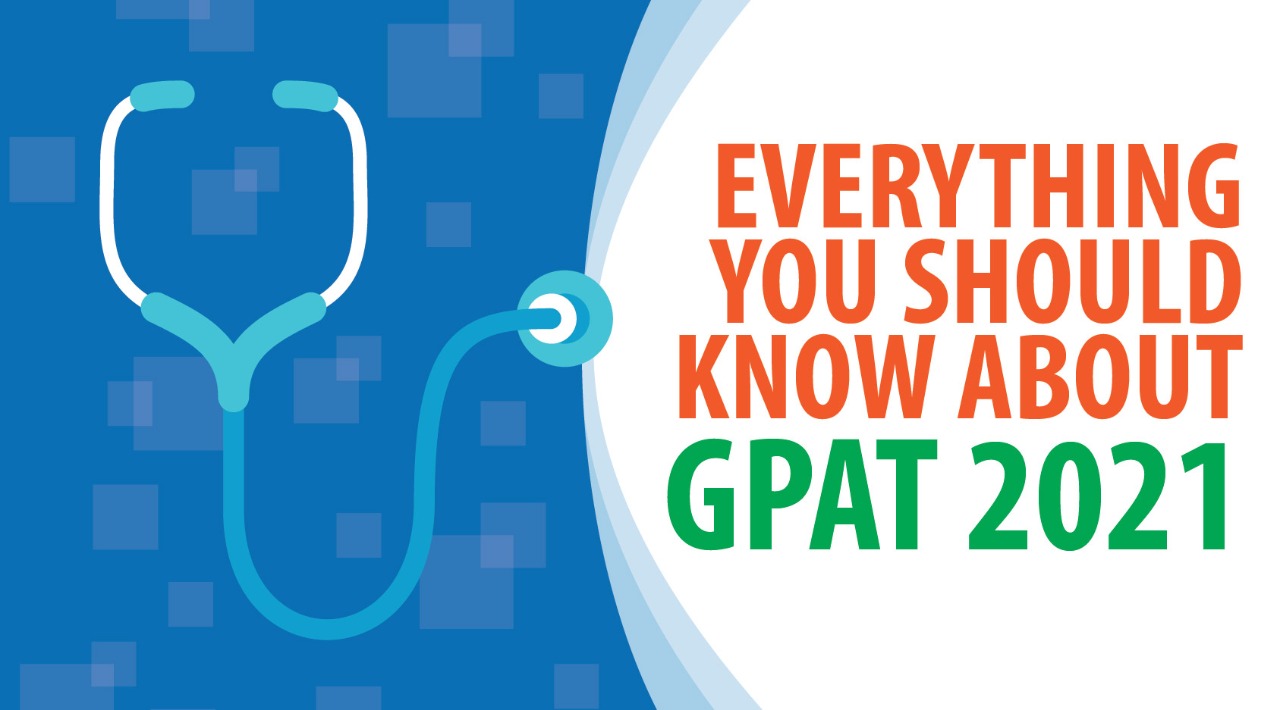By
Editorial
GPAT 2021 (Graduate Pharmacy Aptitude Test) is a national-level pharmacy entrance exam conducted by the NTA (National Testing Agency) every year to give admission in postgraduate Pharmacy (M. Pharm or equivalent courses). Candidates must note that the syllabus and question paper remains the same under the National Testing Agency.
According to the notification, the GPAT 2021 exam will be held on February 22, in online or computer-based mode. The application form of GPAT 2021 has been released on December 23, 2020 at the official website. The last date to complete the GPAT 2021 registration is January 22. A total of 125 objective type questions will be asked from the B.Pharm syllabus as per the GPAT exam pattern 2021.

Read here : GPAT 2021 Exam Pattern, Syllabus, Cutoff
GPAT 2021 Registration:
The Application Form of GPAT 2021 is available on the official website of the conducting body, i.e. NTA from December 23, 2020, and the last date to submit the application form is January 22, 2021.
- After registered for the online application form, write down the system generated application number.
- Submit all the necessary details.
- Set a Password.
- Then choose a security question providing an answer.
GPAT 2021 Exam Pattern:
The conducting body i.e. NTA will release the exam pattern of GPAT2021 with the release of the notification. It is a computer-based or online test with multiple-choice questions, conducted for 3 hours in a single session.
The tabulation below is the highlights of the GPAT 2021 exam pattern that will help the aspirants to gain more details with regard to the exam pattern of GPAT:
| Exam Name |
GPAT 2021 |
| Full-Form |
Graduate Pharmacy Admission Test |
| Conducting Body |
National Testing Agency |
| Exam Language |
English |
| Number of Sections |
4 |
| Exam Duration |
3 hours |
| Exam Frequency |
Once a year |
| Exam Mode |
Online or Computer-based Test |
| Type of Question |
MCQs |
| Number of Questions |
125 |
| Total Marks |
500 |
| Question Format |
Multiple Choice Questions (MCQs) |
| Marking Criteria |
+4 marks for each right answer, -1 mark for every wrong answer |
GPAT 2021 Admission Process:
Applicants are suggested to check the eligibility criteria before applying for the GPAT exam. Mentioned below are the steps for the admission process:
- Go to the official website of the conducting body, i.e. NTA.
- Applicants need to register themselves by clicking on the New Registration tab.
- Give all the details such as phone number, e-mail Id, address, etc.
- Then create a password followed by choosing a security question.
- After the completion of the registration process, candidates will receive an application number.
- Save the application number safe for future references.
GPAT 2021 Exam Syllabus:
The syllabus of GPAT 2021 is released by the conducting body i.e. National Testing Agency and candidates should be aware of and go through the syllabus covered in the entrance examination very well to secure maximum marks. The Tabulation below is the topic-wise syllabus of the GPAT 2021:
| Section Names |
Topics |
| Physical Chemistry |
- Thermodynamics
- Composition and physical states of matter
- Colligative properties
- Refractive index
- Electrochemistry
- Solutions
- Ionic equilibrium
- Kinetics
|
| Physical Pharmacy |
- Micro-metrics and powder rheology
- Matter, properties of matter
- Surface and interfacial phenomenon
- Viscosity and rheology
- Dispersion systems
- Buffer
- Solubility
- Complexation
|
| Organic Chemistry |
- Aromaticity and chemistry of aromatic compounds
- General principles
- Different aromatic classes of compounds
- Different classes of compounds
- Protection and deprotection of groups
- Polycyclic aromatic hydrocarbons
- Carbonyl chemistry
- Heterocyclic chemistry
- Bridged rings
- Kinetic and thermodynamic control
- Stereochemistry
- Carbohydrates
- Amino acids and proteins
- Pericyclic reactions
|
| Pharmaceutics |
- Introduction to pharmaceuticals
- Introduction to the dosage form
- Crude extract
- Sources of drug information
- Allopathic dosage form
- Allergenic extract
- Biological products
- A pharmaceutical plant, location, layout
- Dosage form necessities and additives
- Capsules, Powders, and Tablets
- Parenteral: product requiring sterile packaging
- Suspensions and Emulsions
- Suppositories and Semisolids
- Pharmaceutical aerosols
- Ophthalmic preparations
- Preformulations
- Stability of formulated products
- Prolonged action pharmaceuticals
- Novel drug delivery system
- GMP and validation
- Packaging materials
- Cosmetics
- Pilot plant scale-up techniques
|
| Pharmacology |
- General pharmacology
- Neurohumoral transmission in the autonomic and central nervous system
- Pharmacology of peripheral nervous system, nervous system, and cardiovascular system
- Drugs acting on the urinary system, respiratory system
- Pharmacology of endocrine system
- Chemotherapy
- Autacoids and their antagonists
- Pharmacology of drug acting on the gastrointestinal tract
- Immunopharmacology, Chronopharmacology
- Vitamins and minerals
- Principles of toxicology
|
| Pharmacognosy |
- Introduction to pharmacognosy
- Introduction to phytoconstituents
- Principles of plant classification
- Factors influencing the quality of crude drugs
- Techniques in microscopy
- Pharmaceutical aids
- Animal and Plant products
- Toxic drugs
- Enzymes
- Natural pesticides and insecticides
- Adulteration and evaluation of crude drugs
- Quantitative microscopy
- Biogenetic pathways
- Carbohydrates and lipids
- Volatile oils
- Resinous drugs
- Glycosides
- Alkaloids
- Extraction and isolation techniques
- Phytopharmaceuticals
- Quality control and standardization of herbal drugs
- Herbal formulations
- Worldwide trade of crude drugs and volatile oils
- Traditional herbal drugs
- Plants based industries and research institutes in India
|
| Pharmaceutical Analysis |
- Importance of quality control in pharmacy
- Acid-base titrations
- Non-aqueous titrations
- Oxidation-reduction titrations
- Precipitation titrations
- Complexometric titrations
- Gravimetry, Potentiometry, and Spectrofluorimetry
- Extraction techniques
- Miscellaneous methods of analysis
- Calibration
- General principles of spectroscopy
- Ultraviolet-visible spectrometry
- Flame photometry and atomic absorption spectrometry
- Infrared spectrometry and Mass spectrometry
- Proton nuclear magnetic resonance spectrometry
- Polarography and Chromatography
- Nephelometry and Turbidimetry
|
| Biochemistry |
- Cell
- Carbohydrates
- Proteins and Vitamins
- Lipids
- Biological oxidations and reductions
- Enzymes
- Nucleic acids
- Hereditary diseases
|
| Biotechnology |
- Plant cell and tissue culture
- Animal cell culture
- Fermentation technology and industrial microbiology
- Recombinant DNA technology
- Process and applications
- Biotechnology derived products
|
| Microbiology |
- Introduction to microbiology
- Microscopy and staining technique
- Biology of microorganisms
- Fungi and viruses
- Aseptic technique
- Sterilization and disinfection
- Microbial spoilage
- Vaccines and sera
- Microbial assay
|
| Pathophysiology |
- Basic mechanisms of inflammation and repair
- Basic principles of cell injury and adaptation
- Electrolyte, fluid, and acid-base balance disorders
- Homeostasis disorders: white blood cells, lymphoid tissues, and red blood cells related diseases
- Immunopathology including amyloidosis
- Infectious and Neoplastic diseases
- Pathophysiology of common diseases
- Laboratory tests for liver function tests and kidney function tests
|
| Human Anatomy and Physiology |
- Gastrointestinal tract
- Respiratory system
- Cell physiology
- The blood
- Autonomic nervous system
- Sense organs
- Skeletal system
- Central nervous system
- Urinary system
- Endocrine glands
- Reproductive system
- Cardiovascular system
- Lymphatic system
|
| Pharmaceutical Engineering |
- Heat transfer
- Fluid flow
- Evaporation
- Distillation
- Drying
- Size reduction and size separation
- Extraction
- Mixing
- Crystallization
- Filtration and centrifugation
- Dehumidification and humidity control
- Refrigeration and air conditioning
- Material of constructions
- Automated process control systems
- Industrial hazards and safety precautions
|
| Pharmaceutical Management |
- Introduction
- Planning and forecasting
- Organization
- Research management
- Inventory management
- Communication
- Marketing research
- Leadership and motivation
- Human resource and development
- Standard institutions and regulatory authorities
|
Read also : Pharmacy Career and Job Prospects in India












